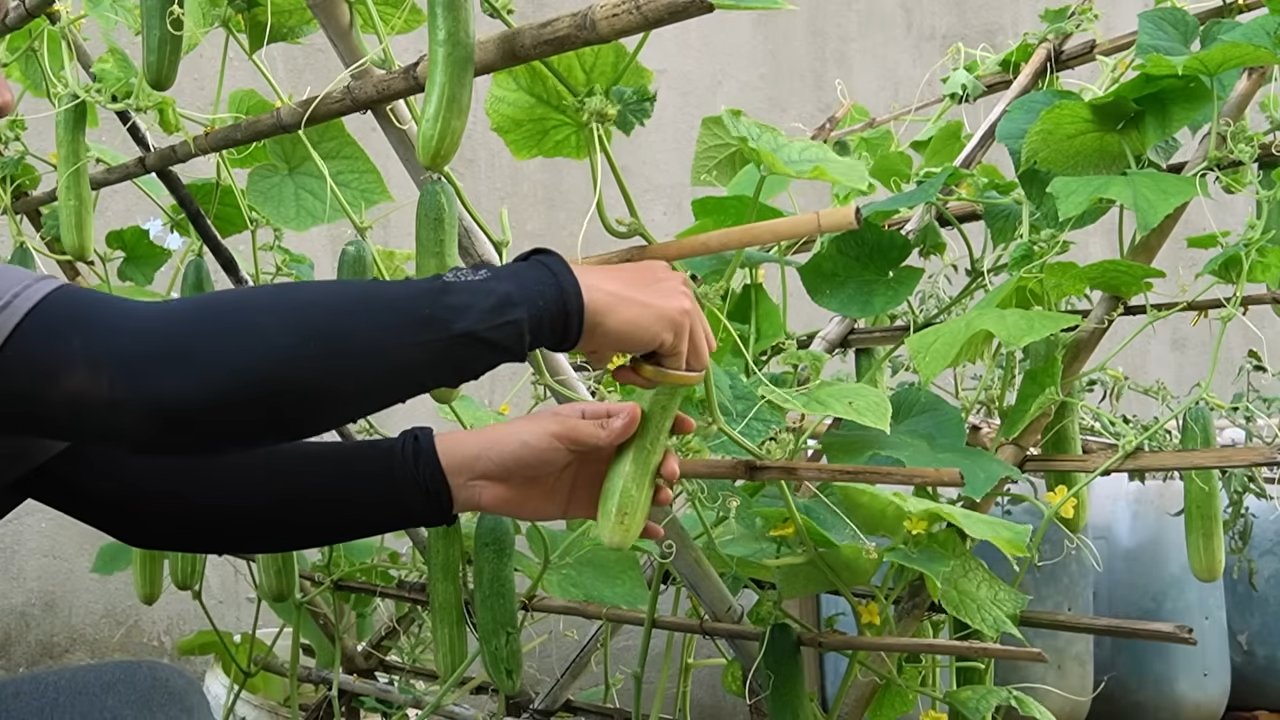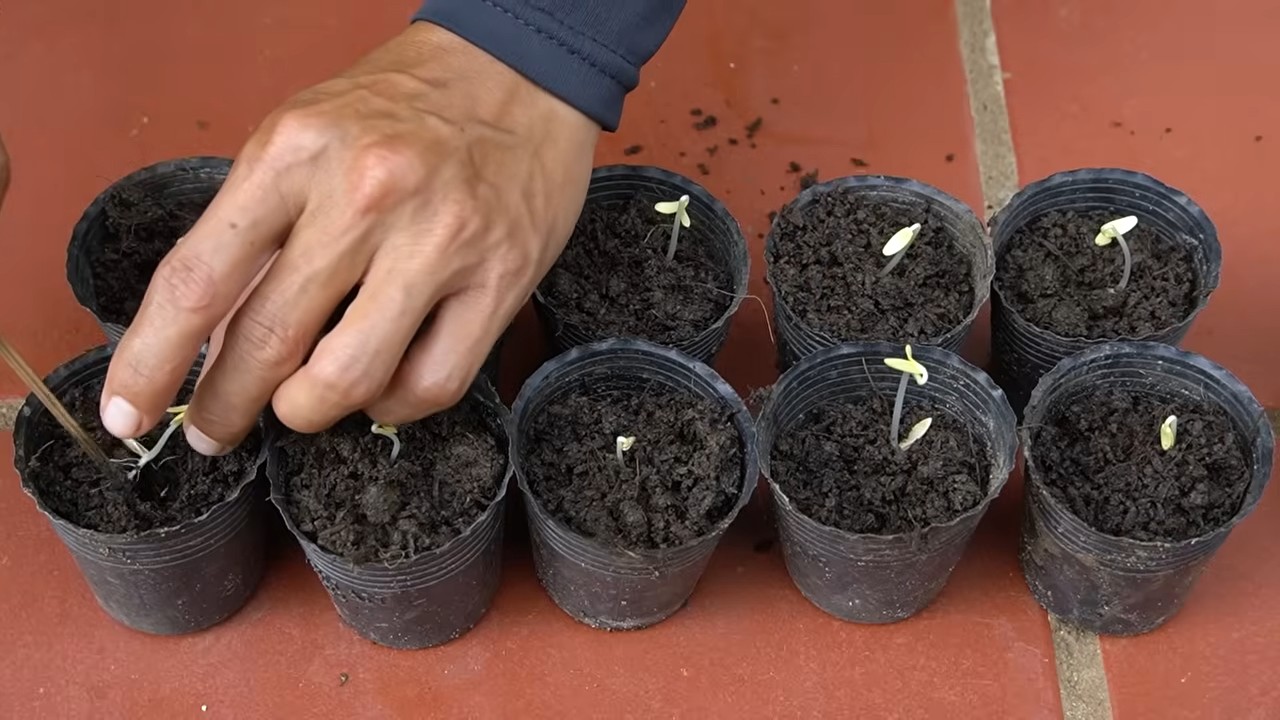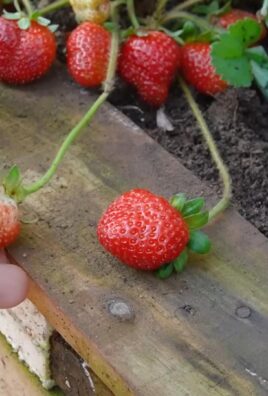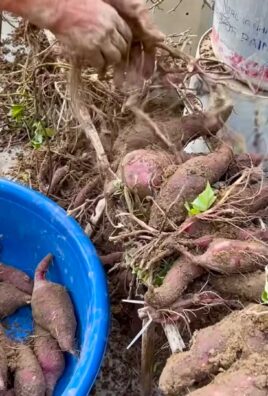Cucumber container gardening: who knew growing your own delicious, crisp cucumbers could be so easy, even without a sprawling backyard? I’m excited to share some simple yet effective DIY tricks that will transform your balcony, patio, or even a sunny windowsill into a thriving cucumber patch!
For centuries, cultivating cucumbers has been a cherished practice across various cultures. From ancient Egypt, where they were enjoyed by pharaohs, to the Roman Empire, where they were prized for their refreshing qualities, cucumbers have a rich and fascinating history. Today, the joy of growing your own food is experiencing a resurgence, and what better way to participate than with these versatile veggies?
Let’s face it, store-bought cucumbers often lack the vibrant flavor and satisfying crunch of homegrown ones. Plus, with concerns about pesticides and the environmental impact of long-distance transportation, growing your own is a healthier and more sustainable choice. These cucumber container gardening hacks will empower you to bypass the grocery store and enjoy fresh, organic cucumbers right from your own home. I’ll guide you through choosing the right container, selecting the perfect cucumber variety, and providing essential care tips to ensure a bountiful harvest. Get ready to impress your friends and family with your green thumb and the delicious results of your labor!

DIY Cucumber Container Gardening: A Bountiful Harvest on Your Patio!
Hey there, fellow gardening enthusiasts! I’m so excited to share my secrets to growing delicious, crisp cucumbers right in containers. Forget sprawling vines taking over your garden; with this guide, you can enjoy a fantastic cucumber harvest even with limited space. Let’s get started!
Choosing the Right Cucumber Variety
First things first, not all cucumbers are created equal, especially when it comes to container gardening. We need to pick varieties that are compact and well-suited for pots.
* Bush Varieties: These are your best bet! They’re bred to be smaller and more manageable. Look for names like ‘Bush Champion,’ ‘Spacemaster,’ ‘Salad Bush,’ or ‘Patio Snacker.’ These are all fantastic choices.
* Compact Vining Varieties: Some vining types can also work, but you’ll need to provide a trellis or support system. ‘Spacemaster’ is a good example of a vining variety that stays relatively compact.
* Avoid Large Vining Types: Steer clear of varieties like ‘Marketmore’ or ‘Straight Eight’ unless you have a *huge* container and a *very* sturdy trellis. They’ll quickly outgrow your space.
Gathering Your Supplies
Okay, now that we’ve got our cucumber variety sorted, let’s gather everything we need. This is my favorite part – getting ready to get my hands dirty!
* Large Container: This is crucial! Cucumbers need plenty of room for their roots to grow. I recommend a container that’s at least 12 inches in diameter and 12 inches deep. Bigger is generally better, so if you have the space, go for a 15-20 inch pot.
* Potting Mix: Don’t use garden soil! It’s too heavy and doesn’t drain well in containers. Instead, opt for a high-quality potting mix that’s light and airy. I like to use a mix that contains peat moss, perlite, and vermiculite.
* Trellis or Support System (if needed): If you’re growing a vining variety, you’ll need something for the vines to climb on. A simple tomato cage, a small trellis, or even bamboo stakes will work.
* Cucumber Seeds or Seedlings: Of course, you can’t grow cucumbers without them! You can start from seed or buy seedlings from your local garden center.
* Slow-Release Fertilizer: This will provide your cucumbers with a steady supply of nutrients throughout the growing season.
* Watering Can or Hose: Essential for keeping your cucumbers hydrated.
* Gardening Gloves: To protect your hands.
* Hand Trowel: For planting.
Planting Your Cucumbers
Alright, let’s get those cucumbers in the ground (or, rather, in the pot!).
1. Prepare the Container: Fill your container with potting mix, leaving about an inch or two of space at the top.
2. Sowing Seeds (if starting from seed): Make a small hole about 1 inch deep. Place 2-3 seeds in each hole. Cover with potting mix and gently water. I always plant a few extra seeds just in case some don’t germinate. Once the seedlings emerge, you can thin them out, leaving the strongest one.
3. Planting Seedlings (if using seedlings): Gently remove the seedling from its container. Loosen the roots a bit with your fingers. Dig a hole in the potting mix that’s large enough to accommodate the root ball. Place the seedling in the hole and cover with potting mix. Gently pat the soil around the base of the plant.
4. Water Thoroughly: After planting, water the soil deeply until water drains out of the bottom of the container. This helps settle the soil and ensures the roots are well-hydrated.
5. Add Slow-Release Fertilizer: Sprinkle a slow-release fertilizer around the base of the plant, following the instructions on the package. This will provide your cucumbers with a steady supply of nutrients.
6. Install Trellis (if needed): If you’re growing a vining variety, install your trellis or support system now. This will give the vines something to climb on as they grow.
Caring for Your Cucumber Plants
Now comes the ongoing care. Consistent attention is key to a healthy and productive cucumber plant.
* Watering: Cucumbers need consistent moisture, especially when they’re fruiting. Water deeply whenever the top inch of soil feels dry to the touch. Avoid overhead watering, as this can lead to fungal diseases. I prefer to water at the base of the plant.
* Fertilizing: In addition to the slow-release fertilizer, you can also supplement with a liquid fertilizer every 2-3 weeks. Look for a fertilizer that’s high in potassium, which promotes fruit production.
* Sunlight: Cucumbers need at least 6-8 hours of sunlight per day. Place your container in a sunny spot where it will receive plenty of light.
* Pruning (if needed): For bush varieties, pruning isn’t usually necessary. However, for vining varieties, you may need to prune the vines to keep them from getting too unruly. You can pinch off the tips of the vines to encourage branching and more fruit production.
* Pest and Disease Control: Keep an eye out for common cucumber pests like aphids, cucumber beetles, and squash bugs. You can control these pests with insecticidal soap or neem oil. Also, watch out for fungal diseases like powdery mildew. To prevent these diseases, make sure your plants have good air circulation and avoid overhead watering. If you spot any signs of disease, treat with a fungicide.
* Pollination: Cucumbers need to be pollinated in order to produce fruit. If you’re growing your cucumbers indoors or in a location where there aren’t many bees, you may need to hand-pollinate them. To do this, use a small paintbrush to transfer pollen from the male flowers to the female flowers. The female flowers have a small cucumber-like structure behind the flower, while the male flowers do not.
Harvesting Your Cucumbers
This is the moment we’ve all been waiting for – harvesting those delicious cucumbers!
* Timing is Key: Cucumbers are usually ready to harvest about 50-70 days after planting, depending on the variety. Check the seed packet or plant tag for specific information.
* Harvest When They’re the Right Size: Harvest your cucumbers when they’re the size you prefer. Smaller cucumbers tend to be more tender and less seedy.
* Use a Sharp Knife or Pruning Shears: Cut the cucumber from the vine, leaving a small stem attached.
* Harvest Regularly: The more you harvest, the more your plants will produce. Check your plants every day or two and harvest any cucumbers that are ready.
Troubleshooting Common Problems
Even with the best care, you might encounter a few challenges along the way. Here are some common problems and how to fix them:
* Yellowing Leaves: This could be a sign of overwatering, underwatering, or nutrient deficiency. Check the soil moisture and adjust your watering accordingly. If the soil is dry, water deeply. If the soil is soggy, let it dry out before watering again. You can also try fertilizing with a balanced fertilizer.
* Misshapen Cucumbers: This is often caused by poor pollination. Make sure your plants are getting enough sunlight and that there are plenty of pollinators in your area. If necessary, hand-pollinate the flowers.
* Bitter Cucumbers: Bitterness can be caused by stress, such as inconsistent watering, high temperatures, or nutrient deficiencies. Try to provide consistent care and avoid stressing your plants.
* Lack of Fruit Production: This could be due to a lack of pollination, insufficient sunlight, or nutrient deficiencies. Make sure your plants are getting enough sunlight and that there are plenty of pollinators in your area. Fertilize with a fertilizer that’s high in potassium.
Extending Your Cucumber Season
Want to keep those cucumbers coming for as long as possible? Here are a few tips:
* Succession Planting: Plant new cucumber seeds or seedlings every few weeks to ensure a continuous harvest.
* Protect from Frost: If you live in an area with cool nights, protect your plants from frost by covering them with a blanket or bringing them indoors.
* Choose Cold-Tolerant Varieties: Some cucumber varieties are more cold-tolerant than others. Look for varieties that are specifically bred for cooler climates.
Enjoying Your Homegrown Cucumbers
Now for the best part – enjoying the fruits (or vegetables!) of your labor! Freshly picked cucumbers are so much more flavorful than store-bought ones. Here are a few ideas for using your homegrown cucumbers:
* Salads: Add sliced cucumbers to your favorite salads for a refreshing crunch.
* Pickles: Make your own homemade pickles! There are tons of easy recipes online.

Conclusion
So, there you have it! Mastering cucumber container gardening is not only achievable, but it’s also incredibly rewarding. We’ve walked through the steps, highlighted the benefits, and armed you with the knowledge to cultivate your own thriving cucumber patch, even without a traditional garden.
Why is this DIY trick a must-try? Because it democratizes gardening. It removes the barriers of space and soil quality, allowing anyone, anywhere, to enjoy the unparalleled taste of homegrown cucumbers. Imagine the satisfaction of harvesting crisp, refreshing cucumbers just steps from your kitchen, knowing exactly where they came from and how they were grown. Store-bought cucumbers simply can’t compare to the vibrant flavor and satisfying crunch of a cucumber nurtured by your own hands.
Beyond the taste, cucumber container gardening offers a therapeutic escape. The simple act of tending to your plants – watering, pruning, and observing their growth – can be incredibly grounding and stress-relieving. It’s a chance to connect with nature, even in the midst of a bustling city.
But the beauty of this DIY approach lies in its adaptability. Feel free to experiment with different cucumber varieties. Bush cucumbers are particularly well-suited for containers, but vining varieties can also thrive with proper support like a trellis or tomato cage. Consider adding companion plants like marigolds or basil to your container to deter pests and enhance the flavor of your cucumbers. You can even try succession planting, sowing new seeds every few weeks, to ensure a continuous harvest throughout the growing season.
Don’t be afraid to get creative with your container choices. While we’ve recommended specific sizes and materials, you can repurpose old buckets, tubs, or even grow bags. Just ensure that your chosen container has adequate drainage and is large enough to accommodate the mature size of your cucumber plant.
We understand that gardening can sometimes feel daunting, especially for beginners. But we encourage you to embrace the learning process and view any challenges as opportunities for growth. Remember, even experienced gardeners encounter setbacks. The key is to learn from your mistakes, adapt your approach, and never give up on your green thumb aspirations.
We are confident that with a little patience and dedication, you’ll be enjoying a bountiful harvest of delicious, homegrown cucumbers in no time. So, grab your seeds, prepare your containers, and embark on this exciting gardening adventure.
We’re eager to hear about your experiences with cucumber container gardening! Share your tips, tricks, and photos in the comments below. Let’s create a community of container gardening enthusiasts and inspire others to discover the joys of growing their own food. What variety of cucumber did you choose? What kind of container did you use? What challenges did you face, and how did you overcome them? Your insights could be invaluable to other aspiring gardeners.
Now, let’s get those cucumbers growing!
Frequently Asked Questions (FAQ)
What is the best type of cucumber to grow in a container?
While many cucumber varieties can be grown in containers, bush varieties are generally the most suitable due to their compact size. These varieties, such as Spacemaster, Bush Champion, and Salad Bush, require less space and are less likely to outgrow their containers. Vining varieties, like Marketmore or Straight Eight, can also be grown in containers, but they will require a trellis or other support structure to climb on. Consider the available space and your preference when choosing a cucumber variety.
How big should my container be for growing cucumbers?
A general rule of thumb is to use a container that is at least 12 inches in diameter and 12 inches deep. However, larger containers (15-20 inches in diameter) are preferable, as they provide more room for the roots to grow and help retain moisture. The size of the container will also depend on the variety of cucumber you are growing. Bush varieties can thrive in slightly smaller containers than vining varieties. Ensure the container has adequate drainage holes to prevent waterlogging.
What type of soil should I use for cucumber container gardening?
Cucumbers thrive in well-draining, nutrient-rich soil. A good potting mix specifically formulated for vegetables is ideal. Avoid using garden soil, as it can be too heavy and compact in containers, hindering root growth. You can also amend your potting mix with compost or other organic matter to improve its fertility and drainage. A slightly acidic to neutral pH (around 6.0 to 7.0) is optimal for cucumber growth.
How often should I water my cucumber plants in containers?
Cucumbers are heavy feeders and require consistent moisture, especially when grown in containers. Water your cucumber plants deeply whenever the top inch of soil feels dry to the touch. This may mean watering daily, especially during hot, dry weather. Avoid overwatering, as this can lead to root rot. Check the drainage holes to ensure that excess water is draining properly. Mulching around the base of the plant can help retain moisture and reduce the frequency of watering.
How much sunlight do cucumbers need when grown in containers?
Cucumbers need at least 6-8 hours of direct sunlight per day to thrive. Choose a location for your container that receives ample sunlight throughout the day. If you live in a particularly hot climate, providing some afternoon shade can help prevent the plants from overheating. If you don’t have access to a sunny location, you can supplement with grow lights.
Do I need to fertilize my cucumber plants in containers?
Yes, cucumbers are heavy feeders and benefit from regular fertilization. Use a balanced fertilizer (e.g., 10-10-10) or a fertilizer specifically formulated for vegetables. Fertilize every 2-3 weeks, following the instructions on the fertilizer package. You can also use organic fertilizers, such as compost tea or fish emulsion. Avoid over-fertilizing, as this can burn the roots and damage the plant.
How do I deal with pests and diseases in my cucumber container garden?
Regularly inspect your cucumber plants for signs of pests or diseases. Common pests include aphids, cucumber beetles, and squash bugs. You can control these pests with insecticidal soap, neem oil, or by hand-picking them off the plants. Common diseases include powdery mildew and downy mildew. To prevent these diseases, ensure good air circulation around the plants, avoid overhead watering, and use disease-resistant cucumber varieties. If you notice signs of disease, treat the plants with a fungicide.
How do I harvest cucumbers from my container garden?
Harvest cucumbers when they reach the desired size and color, typically 6-8 inches long for slicing varieties and 3-5 inches long for pickling varieties. Use a sharp knife or pruning shears to cut the cucumber from the vine, leaving a small stem attached. Regular harvesting encourages the plant to produce more cucumbers. Overripe cucumbers can become bitter and seedy, so it’s important to harvest them at the right time.
Can I grow cucumbers in containers indoors?
Yes, you can grow cucumbers in containers indoors, but it requires more effort and attention. You’ll need to provide adequate light, either through a sunny window or with grow lights. You’ll also need to pollinate the flowers manually, as there will be no bees or other pollinators indoors. Use a small paintbrush to transfer pollen from the male flowers to the female flowers. Indoor cucumber plants may also be more susceptible to pests and diseases, so it’s important to monitor them closely.
What are some companion plants for cucumbers in containers?
Companion planting can benefit cucumber container gardening by attracting beneficial insects, repelling pests, and improving soil health. Good companion plants for cucumbers include marigolds, basil, nasturtiums, dill, and radishes. Avoid planting cucumbers near aromatic herbs like sage, as they can inhibit cucumber growth.




Leave a Comment